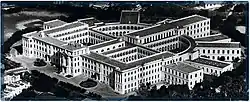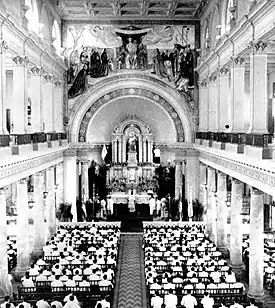| Colegio de Belén | |
|---|---|
 | |
 | |
| Former names | Colegio de Belén |
| General information | |
| Type | Educational |
| Architectural style | Eclectic |
| Location | Marianao |
| Town or city | |
| Country | |
| Coordinates | 23°05′46″N 82°25′01″W / 23.096°N 82.417°W |
| Current tenants | Cuban military |
| Named for | The Palace of Education |
| Opened | 1925 |
| Owner | Cuban military (contested)[lower-alpha 1][2][3] |
| Technical details | |
| Structural system | Steel frame |
| Floor count | 4 |
| Grounds | 60 Acres |
| Design and construction | |
| Architect(s) | Leonardo Morales y Pedroso |
| Architecture firm | Morales & Cia |
The Colegio de Belén located between 45th and 66th streets, situated next door to the Tropicana nightclub, in Marianao, Havana, was designed in 1925 by the architect Leonardo Morales y Pedroso and his brother the engineer Luis Morales y Pedroso of the firm Morales y Compañía Arquitectos.[4]
History


Her Majesty Isabella II, Queen of Spain, issued a royal charter in the year 1854 founding the Colegio de Belén (Belen School) in Havana, Cuba. Belen began its educational work in the building formerly occupied by the convent and convalescent hospital of Our Lady of Belén in Havana Vieja. A meteorological observatory was established in 1857. A facility was built in 1896.[5]
The building was constructed on sixty acres of land that had been donated and was to be used as the main building of the Colegio de Belén. The original building, a convent in Havana Vieja had been opened in 1854 within the premises of the formerly occupied convent and convalescent hospital of Our Lady of Belen. Those premises had become unsuitable and badly located due to the change of atmosphere in the neighborhood and the growth of the city. The project was designed by the Cuban architectural firm of Morales & Cia (architect Leonardo Morales y Pedroso and Engineer Luis Morales y Pedroso) in 1925, with an unlimited budget for designing a religious school, the Colegio de Belén, Havana.[6]

From 1925 to 1961, and located in the Marianao municipality, on an area of approximately 190,000 m2, emerged in the twenties of the last century, the new building with plans approved in Rome by Wlodimiro Ledochowsky, General of the Society of Jesus, in June 1921.
In mid-1923 the construction of this property was started, carried out by the company of architects and engineers Morales y Compañía Arquitectos, being built nine radiating pavilions, a central chapel of three floors, an entrance pavilion that had a fourth level where it was located the observatory. Its inaugural activities were carried out on December 19, 20 and 21, 1925, beginning its first course in January 1926.[4] The result was a monumental pan-optical edifice with an extensive neoclassical façade perpendicular to the large chapel and four large courtyards, recalling the building housing the convent in Havana Vieja, with three stories of porticoed galleries to link nine radial pavilions, the appearance is of instrumentality which is supported both in the design resources and the unusual dimensions of the spaces. The structure is built from the concrete-covered steel structure, the flooring, covered with tiles, and the roof are monolithic reinforced concrete slabs.
Chapel

The chapel was centrally located in plan, it had a wide central nave of triple height with a mural by Hipolito Hidalgo de Caviedes (1901–1994). It had two side aisles. El Colegio de Belen was known as "The Palace of Education."
1961
In 1961 the government of Fidel Castro (himself a graduate of Belen) confiscated all private and religious schools in Cuba. Castro expelled the Jesuits and declared the government of Cuba an atheist government.[7] Castro's government nationalized businesses and banks, confiscating more than $1 billion in American-owned property. Thousands of those dubbed “enemies of the revolution” were executed or imprisoned, and the school curriculum was reshaped by communist doctrine. Free speech was not an option, and the Cuban socialist press was an extension of the government.[7][8]
Rectors in the first Belen school
Calle Compostela, between Luz y Acosta (Havana, 1854-1925).
- 1. Bartolomé Munar (1854-1857)
- 2. Manuel Solís Pajares (Interino 1857-1858)
- 3. José María Lluch (1858-1862)
- 4. Buenaventura Feliú (1862-1868)
- 5. Andrés García Rivas (1868-1874)
- 6. Angel Rosendo Gallo (1874-1881)
- 7. Tomás Ipiña (1881-1885)
- 8. Isidoro Zameza (1885-1889)
- 9. Benigno Iriarte (1889-1893)
- 10. José María Palacio (1893-1899)
- 11. Vicente Leza (1899-1908)
- 12. Silverio Eraña (1908-1909)
- 13. Fernando Ansoleaga(1909-1915)
- 14. Antonino Oráa (1915-1918)
- 15. Pedro Abad 1918-1922
- 16. Claudio García Herrero (1922-1924)
- 17. Camilo García (1924-1925)
Rectors in the new premises of Marianao
- 18. Antonio Galán (1925-1930)
- 19. Enrique Carvajal (1930-1931)
- 20. Ignacio Francia (1931-1938)
- 21. Ramón Calvo Hernández-Agero (1938-1940)
- 22. Daniel Baldor de la Vega (1940-1947)
- 23. Ceferino Ruiz Rodríguez (1947-1953)
- 24. Miguel Angel Larrucea de la Mora (1953-1956)
- 25. Eduardo Martínez Márquez (1956-1959)
- 26. Daniel Baldor de la Vega(1959)
- 27. Ramón Calvo Hernández(1959-1961)[9]
Academics
| Name | Class year | Notability | Reference(s) |
|---|---|---|---|
| Luis E. Aguilar Leon | 1944 | Writer and Professor Emeritus of Georgetown University | [10] |
| Xavier Briggs | 1985 | Currently serving as Associate Director of the White House Office of Management and Budget under President Barack Obama; former senior policy official at the US Department of Housing and Urban Development under President Bill Clinton; Professor of Sociology and Urban Planning at the Massachusetts Institute of Technology (MIT), and a former faculty member of Harvard University’s Kennedy School of Government | [10] |
| Jorge I. Dominguez | 1963 | Faculty member at Harvard University, Academy for International and Area Studies | [10] |
| Alberto Martinez Piedra | 1946 | Former US Ambassador to Guatemala and Professor at The Institute of World Politics | [10] |
| Salvador Miranda | 1958 | Church historian and librarian | [11] |
Politicians, Cuba
| Name | Class year | Notability | Reference(s) |
|---|---|---|---|
| Miguel Ángel de la Campa y Caraveda | 1900 | Cuban Foreign Minister, Attorney General, diplomat | [10] |
| Fidel Castro | 1944 | Former president and prime minister of Cuba | [10] |
| Raul Castro | Attended | Former president and prime minister of Cuba | |
| Antonio Prío Socarrás | 1923 | Cuban Minister of Housing, 1948-1952 | [10] |
| Carlos Prío Socarrás | 1921 | 16th President of Cuba | [10] |
| Francisco Prío Socarrás | 1920 | Cuban Senator, 1944-1952 | [10] |
| Antonio Sánchez de Bustamante y Sirven | 1883 | Cuban Senator (1902–1918), author, and jurist (Judge of the Permanent Court of International Justice at the Hague (1922-1942), nominee for the Nobel Peace Prize of 1949 | [10] |
Scientists
| Name | Class year | Notability | Reference(s) |
|---|---|---|---|
| Carlos Finlay | Faculty | Physician and epidemiologist; proposed the mode of transmission of yellow fever |
Gallery
Images from the 1940s and 50s of the Colegio de Belen:
 Colegio de Belen_Floor plan by Leonardo Morales y Pedroso, ca 1925.
Colegio de Belen_Floor plan by Leonardo Morales y Pedroso, ca 1925. Courtyad, detail.
Courtyad, detail. Hallways
Hallways Auditorium
Auditorium Fidel Castro, 2nd from left. ca. 1943.
Fidel Castro, 2nd from left. ca. 1943. Lunch room
Lunch room Swimmig pool.
Swimmig pool.
See also
Notes
- ↑ This theft of private property led the U.S. into severing diplomatic relations in 1961 and installing the trade embargo and various sanctions against Cuba. "Thousands of Americans and Cuban citizens suffered humiliation and financial distresses of having their private property stolen from them, some of them at gunpoint. Today there has been no justice for that their claims."[1]
References
- ↑ "HEARING BEFORE THE SUBCOMMITTEE ON THE WESTERN HEMISPHERE of the COMMITTEE ON FOREIGN AFFAIRS HOUSE OF REPRESENTATIVES ONE HUNDRED FOURTEENTH CONGRESS FIRST SESSION". Retrieved 2020-02-25.
- ↑ "Trump Administration Authorizes Lawsuits Against Companies That Deal in Property Confiscated by the Cuban Government and Tightens Other Sanctions Against Cuba". Retrieved 2022-05-12.
- ↑ "US Allows Lawsuits Relating to "Trafficking" in Confiscated Property in Cuba". Retrieved 2022-05-12.
- 1 2 "Colegio de Belén". Retrieved 2021-03-21.
- ↑ Mariano Gutiérrez-Lanza (1904). Apuntes historicos acerca del Observatorio del Colegio de Belén, Habana (in Spanish). Havana: Impr. Avisador comercial.
- ↑ "Belen Jesuit Preparatory School". Retrieved 2018-10-10.
- 1 2 "RELIGIOUS REPRESSION IN CUBA: Its Evolution and Present Status". Retrieved 2018-10-11.
- ↑ "Fidel Castro: From Catholic schoolboy to dictator". Retrieved 2018-10-11.
- ↑ "El Colegio de Belén La Habana Cuba 1854 - 1961". Retrieved 2021-04-01.
- 1 2 3 4 5 6 7 8 9 10 The International Jesuit Alumni Directory Belen (Forum Press Inc., 1994)
- ↑ Nardini, Bob (April 2010). "Issues in Vendor/Library Relations -- "I Am the Only Bay of Pigs Librarian"". Against the Grain: Vol. 22: Iss. 2, Article 39.
Bibliography
- La Habana, Guia de Arquitectura, Maria Elena Zequeira & Eduardo Luis Rodriguez Fernandez, editors (Sevilla, Spain: A.G. Novograf, S.A., 1998) ISBN 84-8095-143-5 (in Spanish)
External links
- The Society of Jesus’ Contemporary History in Cuba
- El Colegio de Belén – Escuelas de La Habana
- El célebre observatorio de los jesuitas en La Habana
- Antiguo Convento de Belén hoy proyecto humanitario y museo de la meteorología en La Habana
Colegio de Belén, Havana Q106610781